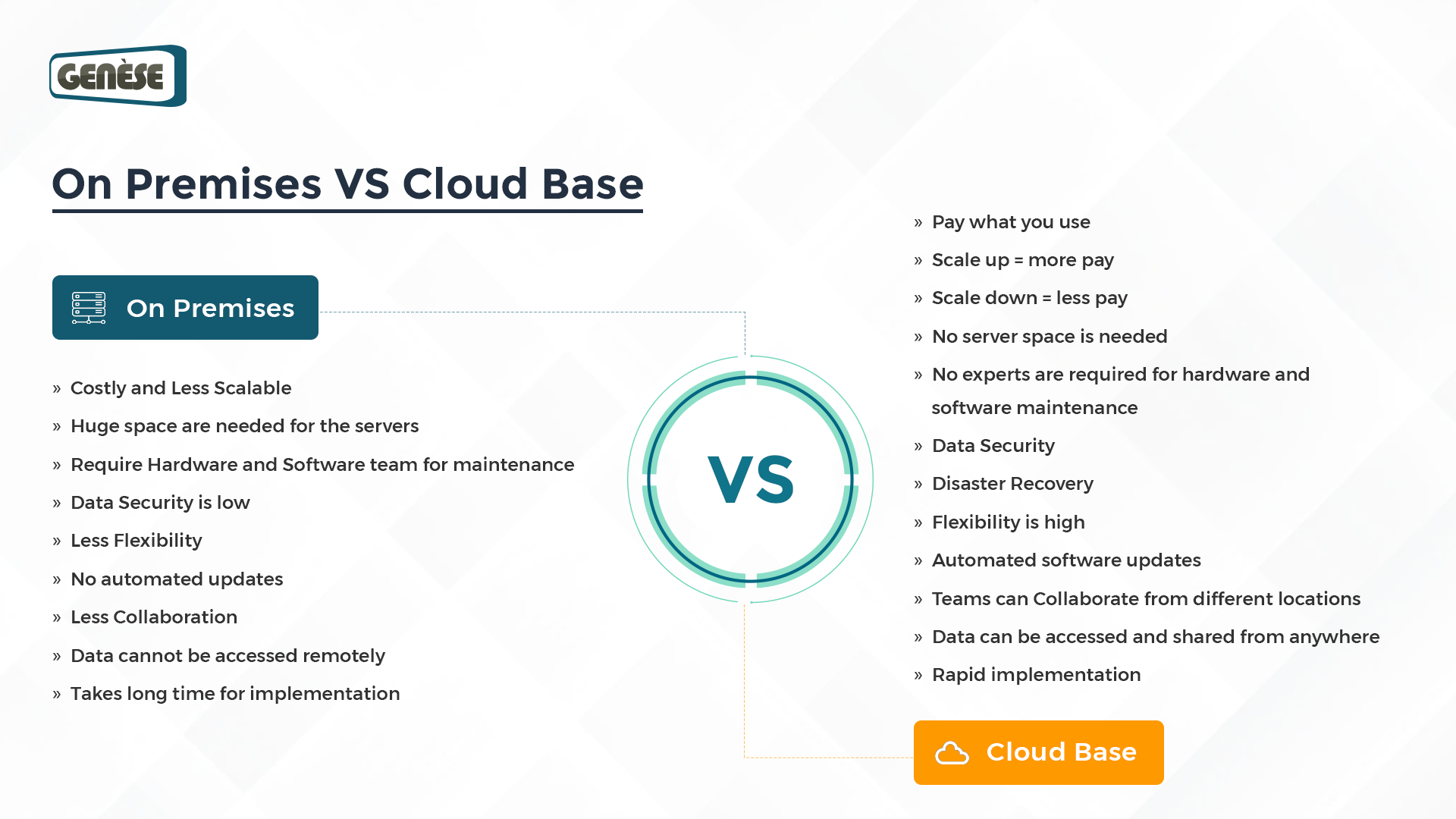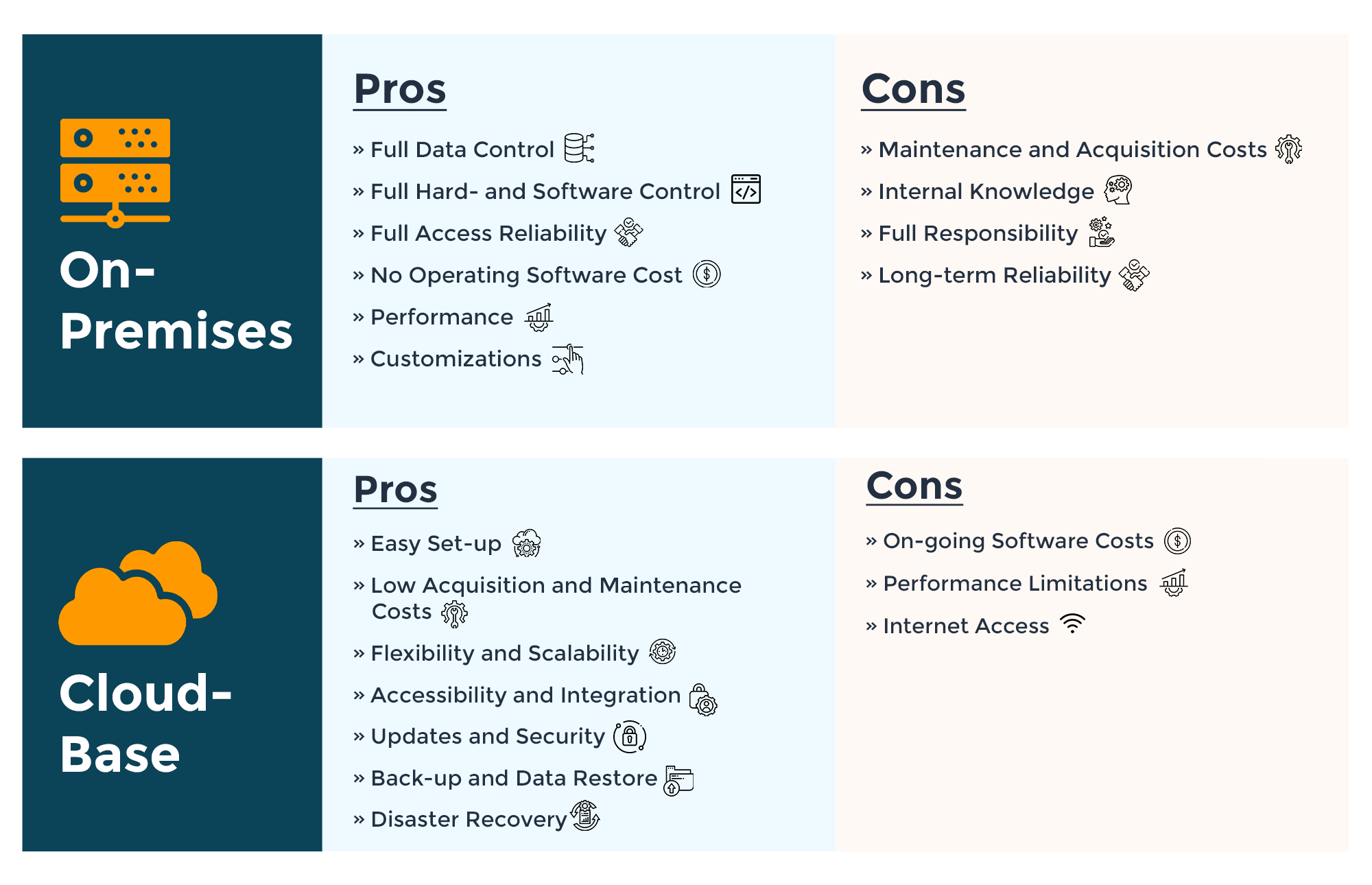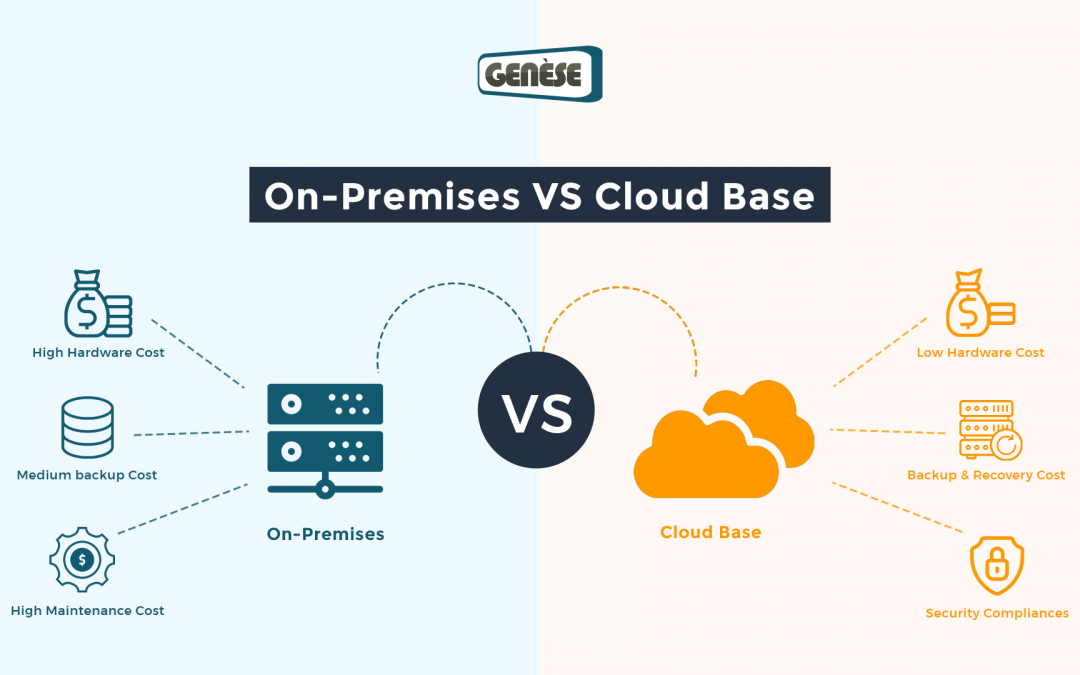- 92% of enterprises surveyed had already adopted a multi-cloud architecture.
- 83% have used the hybrid cloud strategy.
- 98% of businesses still rely on on-premises IT infrastructures.
On-premise Vs. Cloud Base infrastructure
On-premise vs. cloud refers to how software is made available to your company’s employees. On-premise refers to IT infrastructure hardware and software applications that are hosted on on-site servers. Cloud infrastructure is a public cloud (SAAS) solution that is supplied by third-party vendors. The difference is that on-premise is a locally controlled version of the software whereas cloud is an online version. On-premise Vs Cloud Base Comparison Chart
The differences between on-premise and cloud-based are pretty clear. Now let’s explore some of the pros and cons of on-premise and cloud base infrastructure.
On-premise Vs Cloud Base │ Pros and Cons

On-premise | Pros
Full data control: If no private information data is hosted on external servers, data governance and security may be simplified, for example, in relation to GDPR rules or other internal compliance regulations.
Full hardware and software control: Given internal capacity, any difficulties or challenges can be addressed independently and swiftly.
Full access reliability: Data stored on dedicated servers can be accessed locally at any moment, even if the internet connection fails.
No operating software costs: Instead of the conventional subscription models for cloud solutions, software acquisition fees are mostly one-time.
Performance: On-premise systems can achieve outstanding query performance when supplied with the requisite IT infrastructure.
Customization: Although cloud solutions are growing more adaptable, on-premise applications often provide far better potential for highly customized solutions.
On-premise | Cons
Acquisition costs: Providing the full IT infrastructure in-house incurs significant costs for a data center, servers, and other components.
Maintenance costs: Maintaining the gear, network, and current databases necessitates a significant amount of continuing internal investment.
Internal knowledge: An internal IT department is essentially required for the continued professional operation of an on-premise system.
Full responsibility: Full control comes with significantly increased personal responsibility on the part of the administration, whether for solving specific hardware or software problems, implementing security updates on a regular basis, which often incurs additional costs, or ensuring an always up-to-date GDPR-compliant setup.
Long-term reliability: If a chosen product is discontinued and/or updates cease, the advantage of highly customized solutions might become a challenge and a security concern.
Cloud Base | Pros
Easy setup: In-house hardware setup and installation are no longer required due to externally offered infrastructure.
Low acquisition costs: Many service providers enable free test stages that can be started and stopped immediately.
Flexibility and scalability: Cloud infrastructure resources can be altered flexibly, whether in the short term for selectively variable function requirements or for long-term variations in demand, such as as the company’s size and personnel count grows.
Accessibility and integration: Data access is theoretically possible remotely via the Internet at any time, regardless of the user’s device or geographical location.
Low maintenance costs: The provider maintains the necessary resources of the used IT infrastructure, including hardware, servers, and networks.
Updates and security: Cloud solutions are constantly updated to ensure the most up-to-date security rules for sensitive data protection; additionally, outsourcing to the cloud reduces the risk of physical theft of key company data on-premises.
Back-up and Data Restore: Data can be stored in the cloud without capacity constraints and also helps with backup and restore purposes. Once your cloud backup is set up, it requires little to no effort to maintain. Automatic scheduled backups are easy to establish and help keep your stored data current.
Disaster Recovery: Minimizes the chance of data loss since on-premises DR replicates data in near real-time via a local area network (LAN) rather than a slower internet connection used to replicate data to a cloud infrastructure.
Cloud Base | Cons
Ongoing software costs: Instead of a one-time purchase of the software solution, licensing models or subscriptions are used.
Performance limitations: The higher the data volumes to be moved, the more probable cloud solutions will experience speed losses when compared to top on-premise arrangements.
Internet access: In a cloud setting, seamless data access is frequently not possible without a stable Internet connection.
This comparison of on-premise vs. cloud software demonstrates both the advantages and drawbacks, but we can say cloud is becoming much better and gaining more efficiency. As we move towards a more digital future and transformation, cloud will be the core base for the future technologies.
We can minimize the cons of cloud with the expert resources, management and synchronization with the overall operations. Also, the companies with on-premise setups will need to move to cloud slowly towards digital transformation and to uplift their business & expertise.
Genese Solution is prepared for everything in any case. Whether you use your products on-premise, in the AWS cloud, or other cloud solutions, Genese helps to gear towards digital transformation by leveraging cloud technologies.
Learn more about our products and solutions.
 Finland
Finland Bangladesh
Bangladesh
